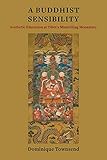A Buddhist sensibility : aesthetic education at Tibet's Mindröling Monastery / Dominique Townsend.
Material type: TextSeries: Description: 1 online resource : illustrationsContent type:
TextSeries: Description: 1 online resource : illustrationsContent type: - text
- computer
- online resource
- 9780231551052
- BQ6349 .B833 2021
- COPYRIGHT NOT covered - Click this link to request copyright permission: https://lib.ciu.edu/copyright-request-form
| Item type | Current library | Collection | Call number | URL | Status | Date due | Barcode | |
|---|---|---|---|---|---|---|---|---|
 Online Book (LOGIN USING YOUR MY CIU LOGIN AND PASSWORD)
Online Book (LOGIN USING YOUR MY CIU LOGIN AND PASSWORD)
|
G. Allen Fleece Library ONLINE | Non-fiction | BQ6349.59 (Browse shelf(Opens below)) | Link to resource | Available | on1159791471 |
Revision of author's thesis (doctoral)--Columbia University, 2012, titled Materials of Buddhist culture : aesthetics and cosmopolitanism at Mindroling Monastery.
Includes bibliographies and index.
Introduction: Buddhist aesthetics, the cultivation of the senses, and beauty's efficacy -- Historical background : laying the foundation for Mindröling -- A pleasure grove for the Buddhist senses : Mindröling takes root -- Plucking the strings : on style, letter writing, and relationships -- Training the senses : aesthetic education for monastics -- Taming the aristocrats : cultivating early modern Tibetan Buddhist literati and bureaucrats -- Epilogue: The next generation and beyond.
"Founded in 1676 during a cosmopolitan early modern period, Mindröling monastery became a key site for Buddhist education and a Tibetan civilizational center. Its founders sought to systematize and institutionalize a worldview rooted in Buddhist philosophy, engaging with contemporaries from across Tibetan Buddhist schools while crystallizing what it meant to be part of their own Nyingma school. At the monastery, ritual performance, meditation, renunciation, and training in the skills of a bureaucrat or member of the literati went hand in hand. Studying at Mindröling entailed training the senses and cultivating the objects of the senses through poetry, ritual music, monastic dance, visual arts, and incense production, as well as medicine and astrology. Dominique Townsend investigates the ritual, artistic, and cultural practices inculcated at Mindröling to demonstrate how early modern Tibetans integrated Buddhist and worldly activities through training in aesthetics. Considering laypeople as well as monastics and women as well as men, A Buddhist Sensibility sheds new light on the forms of knowledge valued in early modern Tibetan societies, especially among the ruling classes. Townsend traces how tastes, values, and sensibilities were cultivated and spread, showing what it meant for a person, lay or monastic, to be deemed well educated. Combining historical and literary analysis with fieldwork in Tibetan Buddhist communities, this book reveals how monastic institutions work as centers of cultural production beyond the boundaries of what is conventionally deemed Buddhist"--
COPYRIGHT NOT covered - Click this link to request copyright permission:
There are no comments on this title.
